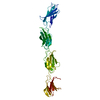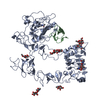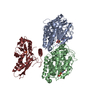[English] 日本語
 Yorodumi
Yorodumi- PDB-3qwq: Crystal structure of the extracellular domain of the epidermal gr... -
+ Open data
Open data
- Basic information
Basic information
| Entry | Database: PDB / ID: 3qwq | |||||||||
|---|---|---|---|---|---|---|---|---|---|---|
| Title | Crystal structure of the extracellular domain of the epidermal growth factor receptor in complex with an adnectin | |||||||||
 Components Components |
| |||||||||
 Keywords Keywords | PROTEIN BINDING/SIGNALING PROTEIN /  CELL SURFACE RECEPTOR / CELL SURFACE RECEPTOR /  TYROSINE KINASE / TYROSINE KINASE /  GLYCOPROTEIN / GLYCOPROTEIN /  ADNECTIN / ADNECTIN /  ANTITUMOR / ANTITUMOR /  DRUG / ENGINEERED BINDING PROTEIN / ANTIBODY MIMIC / DRUG / ENGINEERED BINDING PROTEIN / ANTIBODY MIMIC /  SIGNALING PROTEIN / PROTEIN BINDING-SIGNALING PROTEIN complex SIGNALING PROTEIN / PROTEIN BINDING-SIGNALING PROTEIN complex | |||||||||
| Function / homology |  Function and homology information Function and homology informationresponse to hydroxyisoflavone /  multivesicular body, internal vesicle lumen / positive regulation of prolactin secretion / negative regulation of cardiocyte differentiation / positive regulation of protein kinase C activity / diterpenoid metabolic process / Shc-EGFR complex / multivesicular body, internal vesicle lumen / positive regulation of prolactin secretion / negative regulation of cardiocyte differentiation / positive regulation of protein kinase C activity / diterpenoid metabolic process / Shc-EGFR complex /  ovulation cycle / Inhibition of Signaling by Overexpressed EGFR / ovulation cycle / Inhibition of Signaling by Overexpressed EGFR /  epidermal growth factor receptor activity ...response to hydroxyisoflavone / epidermal growth factor receptor activity ...response to hydroxyisoflavone /  multivesicular body, internal vesicle lumen / positive regulation of prolactin secretion / negative regulation of cardiocyte differentiation / positive regulation of protein kinase C activity / diterpenoid metabolic process / Shc-EGFR complex / multivesicular body, internal vesicle lumen / positive regulation of prolactin secretion / negative regulation of cardiocyte differentiation / positive regulation of protein kinase C activity / diterpenoid metabolic process / Shc-EGFR complex /  ovulation cycle / Inhibition of Signaling by Overexpressed EGFR / ovulation cycle / Inhibition of Signaling by Overexpressed EGFR /  epidermal growth factor receptor activity / EGFR interacts with phospholipase C-gamma / positive regulation of mucus secretion / response to UV-A / epidermal growth factor receptor activity / EGFR interacts with phospholipase C-gamma / positive regulation of mucus secretion / response to UV-A /  epidermal growth factor binding / PLCG1 events in ERBB2 signaling / tongue development / midgut development / ERBB2-EGFR signaling pathway / hydrogen peroxide metabolic process / PTK6 promotes HIF1A stabilization / digestive tract morphogenesis / epidermal growth factor binding / PLCG1 events in ERBB2 signaling / tongue development / midgut development / ERBB2-EGFR signaling pathway / hydrogen peroxide metabolic process / PTK6 promotes HIF1A stabilization / digestive tract morphogenesis /  regulation of nitric-oxide synthase activity / morphogenesis of an epithelial fold / ERBB2 Activates PTK6 Signaling / intracellular vesicle / Signaling by EGFR / response to cobalamin / regulation of nitric-oxide synthase activity / morphogenesis of an epithelial fold / ERBB2 Activates PTK6 Signaling / intracellular vesicle / Signaling by EGFR / response to cobalamin /  transmembrane receptor protein tyrosine kinase activator activity / protein tyrosine kinase activator activity / negative regulation of epidermal growth factor receptor signaling pathway / Signaling by ERBB4 / regulation of phosphatidylinositol 3-kinase/protein kinase B signal transduction / eyelid development in camera-type eye / protein insertion into membrane / cerebral cortex cell migration / ERBB2 Regulates Cell Motility / regulation of JNK cascade / : / PI3K events in ERBB2 signaling / positive regulation of cyclin-dependent protein serine/threonine kinase activity / negative regulation of mitotic cell cycle / hair follicle development / transmembrane receptor protein tyrosine kinase activator activity / protein tyrosine kinase activator activity / negative regulation of epidermal growth factor receptor signaling pathway / Signaling by ERBB4 / regulation of phosphatidylinositol 3-kinase/protein kinase B signal transduction / eyelid development in camera-type eye / protein insertion into membrane / cerebral cortex cell migration / ERBB2 Regulates Cell Motility / regulation of JNK cascade / : / PI3K events in ERBB2 signaling / positive regulation of cyclin-dependent protein serine/threonine kinase activity / negative regulation of mitotic cell cycle / hair follicle development /  MAP kinase kinase kinase activity / Estrogen-dependent nuclear events downstream of ESR-membrane signaling / embryonic placenta development / positive regulation of bone resorption / positive regulation of G1/S transition of mitotic cell cycle / GAB1 signalosome / positive regulation of nitric oxide mediated signal transduction / salivary gland morphogenesis / peptidyl-tyrosine autophosphorylation / regulation of peptidyl-tyrosine phosphorylation / positive regulation of phosphorylation / positive regulation of glial cell proliferation / positive regulation of vasoconstriction / Signaling by ERBB2 / cellular response to epidermal growth factor stimulus / cellular response to cadmium ion / GRB2 events in EGFR signaling / SHC1 events in EGFR signaling / positive regulation of DNA repair / EGFR Transactivation by Gastrin / GRB2 events in ERBB2 signaling / TFAP2 (AP-2) family regulates transcription of growth factors and their receptors / MAP kinase kinase kinase activity / Estrogen-dependent nuclear events downstream of ESR-membrane signaling / embryonic placenta development / positive regulation of bone resorption / positive regulation of G1/S transition of mitotic cell cycle / GAB1 signalosome / positive regulation of nitric oxide mediated signal transduction / salivary gland morphogenesis / peptidyl-tyrosine autophosphorylation / regulation of peptidyl-tyrosine phosphorylation / positive regulation of phosphorylation / positive regulation of glial cell proliferation / positive regulation of vasoconstriction / Signaling by ERBB2 / cellular response to epidermal growth factor stimulus / cellular response to cadmium ion / GRB2 events in EGFR signaling / SHC1 events in EGFR signaling / positive regulation of DNA repair / EGFR Transactivation by Gastrin / GRB2 events in ERBB2 signaling / TFAP2 (AP-2) family regulates transcription of growth factors and their receptors /  transmembrane receptor protein tyrosine kinase activity / SHC1 events in ERBB2 signaling / transmembrane receptor protein tyrosine kinase activity / SHC1 events in ERBB2 signaling /  ossification / positive regulation of synaptic transmission, glutamatergic / ossification / positive regulation of synaptic transmission, glutamatergic /  neurogenesis / cellular response to dexamethasone stimulus / basal plasma membrane / regulation of ERK1 and ERK2 cascade / neuron projection morphogenesis / positive regulation of superoxide anion generation / positive regulation of DNA replication / Signal transduction by L1 / epithelial cell proliferation / cellular response to estradiol stimulus / NOTCH3 Activation and Transmission of Signal to the Nucleus / positive regulation of epithelial cell proliferation / astrocyte activation / neurogenesis / cellular response to dexamethasone stimulus / basal plasma membrane / regulation of ERK1 and ERK2 cascade / neuron projection morphogenesis / positive regulation of superoxide anion generation / positive regulation of DNA replication / Signal transduction by L1 / epithelial cell proliferation / cellular response to estradiol stimulus / NOTCH3 Activation and Transmission of Signal to the Nucleus / positive regulation of epithelial cell proliferation / astrocyte activation /  liver regeneration / positive regulation of protein localization to plasma membrane / EGFR downregulation / liver regeneration / positive regulation of protein localization to plasma membrane / EGFR downregulation /  cell surface receptor protein tyrosine kinase signaling pathway / cellular response to amino acid stimulus / positive regulation of smooth muscle cell proliferation / Signaling by ERBB2 TMD/JMD mutants / positive regulation of MAP kinase activity / clathrin-coated endocytic vesicle membrane / lung development / Constitutive Signaling by EGFRvIII / Signaling by ERBB2 ECD mutants / epidermal growth factor receptor signaling pathway / Signaling by ERBB2 KD Mutants / negative regulation of protein catabolic process / cell surface receptor protein tyrosine kinase signaling pathway / cellular response to amino acid stimulus / positive regulation of smooth muscle cell proliferation / Signaling by ERBB2 TMD/JMD mutants / positive regulation of MAP kinase activity / clathrin-coated endocytic vesicle membrane / lung development / Constitutive Signaling by EGFRvIII / Signaling by ERBB2 ECD mutants / epidermal growth factor receptor signaling pathway / Signaling by ERBB2 KD Mutants / negative regulation of protein catabolic process /  receptor protein-tyrosine kinase / Downregulation of ERBB2 signaling / receptor protein-tyrosine kinase / Downregulation of ERBB2 signaling /  kinase binding / ruffle membrane kinase binding / ruffle membraneSimilarity search - Function | |||||||||
| Biological species |   Homo sapiens (human) Homo sapiens (human) | |||||||||
| Method |  X-RAY DIFFRACTION / X-RAY DIFFRACTION /  SYNCHROTRON / SYNCHROTRON /  MOLECULAR REPLACEMENT / Resolution: 2.75 Å MOLECULAR REPLACEMENT / Resolution: 2.75 Å | |||||||||
 Authors Authors | Sheriff, S. | |||||||||
 Citation Citation |  Journal: Structure / Year: 2012 Journal: Structure / Year: 2012Title: Structures of adnectin/protein complexes reveal an expanded binding footprint. Authors: Ramamurthy, V. / Krystek, S.R. / Bush, A. / Wei, A. / Emanuel, S.L. / Das Gupta, R. / Janjua, A. / Cheng, L. / Murdock, M. / Abramczyk, B. / Cohen, D. / Lin, Z. / Morin, P. / Davis, J.H. / ...Authors: Ramamurthy, V. / Krystek, S.R. / Bush, A. / Wei, A. / Emanuel, S.L. / Das Gupta, R. / Janjua, A. / Cheng, L. / Murdock, M. / Abramczyk, B. / Cohen, D. / Lin, Z. / Morin, P. / Davis, J.H. / Dabritz, M. / McLaughlin, D.C. / Russo, K.A. / Chao, G. / Wright, M.C. / Jenny, V.A. / Engle, L.J. / Furfine, E. / Sheriff, S. | |||||||||
| History |
|
- Structure visualization
Structure visualization
| Structure viewer | Molecule:  Molmil Molmil Jmol/JSmol Jmol/JSmol |
|---|
- Downloads & links
Downloads & links
- Download
Download
| PDBx/mmCIF format |  3qwq.cif.gz 3qwq.cif.gz | 297.1 KB | Display |  PDBx/mmCIF format PDBx/mmCIF format |
|---|---|---|---|---|
| PDB format |  pdb3qwq.ent.gz pdb3qwq.ent.gz | 238.8 KB | Display |  PDB format PDB format |
| PDBx/mmJSON format |  3qwq.json.gz 3qwq.json.gz | Tree view |  PDBx/mmJSON format PDBx/mmJSON format | |
| Others |  Other downloads Other downloads |
-Validation report
| Arichive directory |  https://data.pdbj.org/pub/pdb/validation_reports/qw/3qwq https://data.pdbj.org/pub/pdb/validation_reports/qw/3qwq ftp://data.pdbj.org/pub/pdb/validation_reports/qw/3qwq ftp://data.pdbj.org/pub/pdb/validation_reports/qw/3qwq | HTTPS FTP |
|---|
-Related structure data
| Related structure data |  3qwrC  1fnfS  1nqlS C: citing same article ( S: Starting model for refinement |
|---|---|
| Similar structure data |
- Links
Links
- Assembly
Assembly
| Deposited unit | 
| ||||||||
|---|---|---|---|---|---|---|---|---|---|
| 1 |
| ||||||||
| Unit cell |
|
- Components
Components
-Protein , 2 types, 2 molecules AB
| #1: Protein |  / Proto-oncogene c-ErbB-1 / Receptor tyrosine-protein kinase erbB-1 / Proto-oncogene c-ErbB-1 / Receptor tyrosine-protein kinase erbB-1Mass: 71465.453 Da / Num. of mol.: 1 / Fragment: ECTODOMAIN Source method: isolated from a genetically manipulated source Source: (gene. exp.)   Homo sapiens (human) / Gene: EGFR, ERBB1 / Production host: Homo sapiens (human) / Gene: EGFR, ERBB1 / Production host:   Spodoptera frugiperda (fall armyworm) / Strain (production host): SF9 Spodoptera frugiperda (fall armyworm) / Strain (production host): SF9References: UniProt: P00533,  receptor protein-tyrosine kinase receptor protein-tyrosine kinase |
|---|---|
| #2: Protein |  Monobody MonobodyMass: 12604.813 Da / Num. of mol.: 1 Source method: isolated from a genetically manipulated source Source: (gene. exp.)   Homo sapiens (human) / Plasmid: PET9 PCT734 / Production host: Homo sapiens (human) / Plasmid: PET9 PCT734 / Production host:   Escherichia coli (E. coli) / Strain (production host): HMS174 Escherichia coli (E. coli) / Strain (production host): HMS174 |
-Sugars , 4 types, 6 molecules 
| #3: Polysaccharide |  / Mass: 1056.964 Da / Num. of mol.: 2 / Mass: 1056.964 Da / Num. of mol.: 2Source method: isolated from a genetically manipulated source #4: Polysaccharide | beta-D-mannopyranose-(1-4)-2-acetamido-2-deoxy-beta-D-glucopyranose-(1-4)-2-acetamido-2-deoxy-beta- ...beta-D-mannopyranose-(1-4)-2-acetamido-2-deoxy-beta-D-glucopyranose-(1-4)-2-acetamido-2-deoxy-beta-D-glucopyranose |  / Mass: 586.542 Da / Num. of mol.: 1 / Mass: 586.542 Da / Num. of mol.: 1Source method: isolated from a genetically manipulated source #5: Polysaccharide | 2-acetamido-2-deoxy-beta-D-glucopyranose-(1-4)-2-acetamido-2-deoxy-beta-D-glucopyranose |  / Mass: 424.401 Da / Num. of mol.: 1 / Mass: 424.401 Da / Num. of mol.: 1Source method: isolated from a genetically manipulated source #6: Sugar |  N-Acetylglucosamine N-Acetylglucosamine |
|---|
-Non-polymers , 1 types, 14 molecules 
| #7: Water | ChemComp-HOH /  Water Water |
|---|
-Experimental details
-Experiment
| Experiment | Method:  X-RAY DIFFRACTION / Number of used crystals: 1 X-RAY DIFFRACTION / Number of used crystals: 1 |
|---|
- Sample preparation
Sample preparation
| Crystal | Density Matthews: 3.82 Å3/Da / Density % sol: 67.8 % |
|---|---|
Crystal grow | Temperature: 293 K / pH: 7 Details: 60% Tacsimate, pH 7.0, vapor diffusion, hanging drop, temperature 293K |
-Data collection
| Diffraction | Mean temperature: 100 K |
|---|---|
| Diffraction source | Source:  SYNCHROTRON / Site: SYNCHROTRON / Site:  APS APS  / Beamline: 21-ID-G / Wavelength: 0.979 / Beamline: 21-ID-G / Wavelength: 0.979 |
| Detector | Type: RAYONIX MX-300 / Detector: CCD / Date: Apr 5, 2009 |
| Radiation | Protocol: SINGLE WAVELENGTH / Monochromatic (M) / Laue (L): M / Scattering type: x-ray |
| Radiation wavelength | Wavelength : 0.979 Å / Relative weight: 1 : 0.979 Å / Relative weight: 1 |
| Reflection | Resolution: 2.75→50 Å / Num. obs: 34285 / % possible obs: 99.6 % / Observed criterion σ(I): 0 / Redundancy: 4.8 % / Biso Wilson estimate: 71.5 Å2 / Rmerge(I) obs: 0.069 / Net I/σ(I): 23.1 |
| Reflection shell | Resolution: 2.75→2.85 Å / Redundancy: 5 % / Rmerge(I) obs: 0.552 / Mean I/σ(I) obs: 3.1 / % possible all: 100 |
- Processing
Processing
| Software |
| ||||||||||||||||||||||||||||||||||||||||||||||||||||||||||||||||||||||||||||||||||||||||||||||||||||||||||||||||||
|---|---|---|---|---|---|---|---|---|---|---|---|---|---|---|---|---|---|---|---|---|---|---|---|---|---|---|---|---|---|---|---|---|---|---|---|---|---|---|---|---|---|---|---|---|---|---|---|---|---|---|---|---|---|---|---|---|---|---|---|---|---|---|---|---|---|---|---|---|---|---|---|---|---|---|---|---|---|---|---|---|---|---|---|---|---|---|---|---|---|---|---|---|---|---|---|---|---|---|---|---|---|---|---|---|---|---|---|---|---|---|---|---|---|---|---|
| Refinement | Method to determine structure : :  MOLECULAR REPLACEMENT MOLECULAR REPLACEMENTStarting model: EGFR FROM PDB ENTRY 1NQL AND ADNECTIN FROM PDB ENTRY 1FNF RESIDUES 1421-1437, 1444-1466, 1470-1491, 1502-1509 Resolution: 2.75→49.47 Å / Cor.coef. Fo:Fc: 0.928 / Cor.coef. Fo:Fc free: 0.908 / Occupancy max: 1 / Occupancy min: 1 / SU R Cruickshank DPI: 0.38 / Cross valid method: THROUGHOUT / σ(F): 0 / SU R Blow DPI: 0.38 / SU Rfree Blow DPI: 0.27 / SU Rfree Cruickshank DPI: 0.27
| ||||||||||||||||||||||||||||||||||||||||||||||||||||||||||||||||||||||||||||||||||||||||||||||||||||||||||||||||||
| Displacement parameters | Biso mean: 64.63 Å2
| ||||||||||||||||||||||||||||||||||||||||||||||||||||||||||||||||||||||||||||||||||||||||||||||||||||||||||||||||||
| Refine analyze | Luzzati coordinate error obs: 0.39 Å | ||||||||||||||||||||||||||||||||||||||||||||||||||||||||||||||||||||||||||||||||||||||||||||||||||||||||||||||||||
| Refinement step | Cycle: LAST / Resolution: 2.75→49.47 Å
| ||||||||||||||||||||||||||||||||||||||||||||||||||||||||||||||||||||||||||||||||||||||||||||||||||||||||||||||||||
| Refine LS restraints |
| ||||||||||||||||||||||||||||||||||||||||||||||||||||||||||||||||||||||||||||||||||||||||||||||||||||||||||||||||||
| LS refinement shell | Resolution: 2.75→2.83 Å / Total num. of bins used: 17
| ||||||||||||||||||||||||||||||||||||||||||||||||||||||||||||||||||||||||||||||||||||||||||||||||||||||||||||||||||
| Refinement TLS params. | Method: refined / Refine-ID: X-RAY DIFFRACTION
| ||||||||||||||||||||||||||||||||||||||||||||||||||||||||||||||||||||||||||||||||||||||||||||||||||||||||||||||||||
| Refinement TLS group |
|
 Movie
Movie Controller
Controller










 PDBj
PDBj













